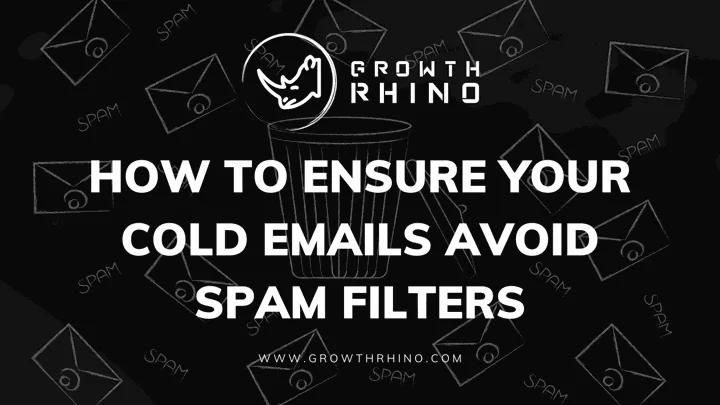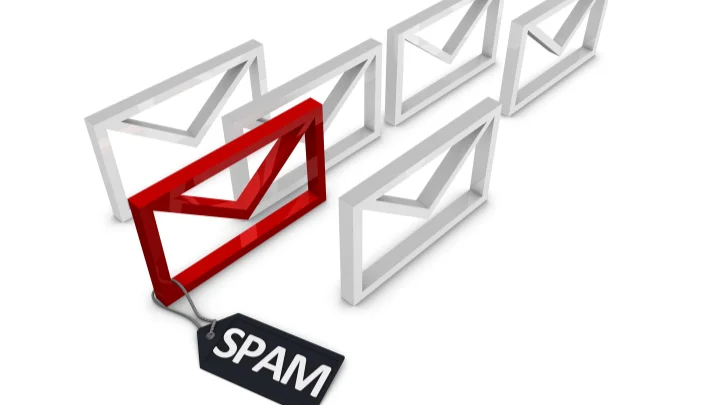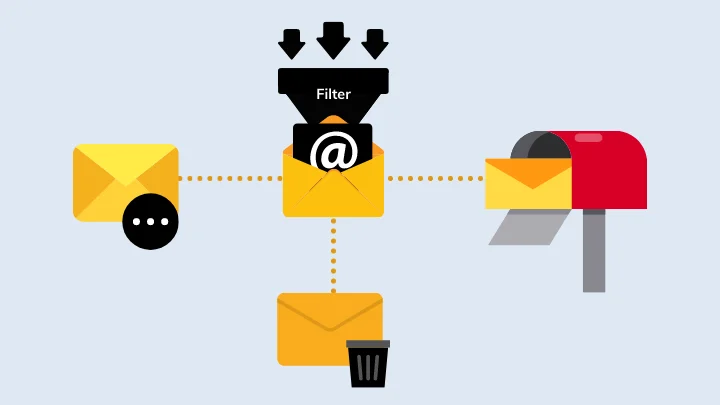
The business of email marketing keeps companies on their toes and under the constant pressure of thinking and rethinking the spam traps. Internet service providers have become brutal in their screenings, and research reveals that only 79% of the emails sent by genuine email marketers reach the recipient email addresses. Hence, emails should be crafted to avoid landing in spam or being marked as spam by the subscribers. Therefore, it is important for agencies to focus on learning the spam trigger words and anti-spam laws to avoid getting spammed. Here is a comprehensive guide to help you understand the dos and don'ts of sending emails and how to avoid spam filters to stay safe from spam troubles.
What are spam filters?
Spam filters are the defense line for the internet service providers (ISPs). They filter out the unwanted and unsolicited bulk emails that a recipient receives. This filter, hence, prevents the emails from entering the email inboxes. The main task of the spam filters is to scrutinize targeted emails thoroughly to make sure no irrelevant content makes its way to the inbox.

The importance of spam filters:
The spams that enter the inboxes are generally harmless. Still, email providers use spam filters to ensure that the user’s experience is as annoyance-free as possible. Without spam filters, the spam emails would fill up the inboxes to the point where there would not be space for legitimate emails. The presence of spam filters is also significant for the following reasons:
- Spam filters quickly detect unsolicited, unwanted, and virus-infected emails.
- The spam emails might also contain some malicious content that can make the entry of malware easy.
- They help uphold the email quality entering the inbox.
Using a spam filter, companies can have their valuable assets protected, including their workstations, servers, and other network elements.
How does a cold email spam filter work?
Spam filters have a variety of criteria that assess incoming emails. They look thoroughly at each of the factors and assign the email a spam score. This score is the determining factor of whether the email will pass through the filter or get stuck. The score normally depends on the server, so there are chances that the email might pass some inboxes but not others. There are multiple compliant senders and permission-based audiences who can get flagged by aggressive spamming. The best way to not get trapped in these spam traps is by understanding the tips to avoiding them.

Tips to avoid spam filters:
Multiple technical issues need the attention of the businesses even before the email campaigns are starting. Email marketing must be in a particular flow so as not to trigger any spam filters that block the easy passage of business emails. Besides these, there are certain tips that will come in handy:

Build the domain’s reputation first:
Avoiding spam filters gets easier when emails appear from a legitimate sender. Spam filters generally affect the domain reputation and question your reliability as a sender. To encourage emails to make their way to the inbox, it is necessary to maintain your email reputation. There are a few factors you can use to assess the domain reputation:
Spam rate- This determines what percentage of emails were already filtered out from a sender’s list that directly ended up in the spam folder.
Bounce rate- This determines the percentage of emails that were sent by a domain and were rejected by the receiver’s email server and returned to the sender directly.
Spam report- This determines the number of email receivers who actually marked your email as spam. Spam reports are not something that is desired by businesses and sets off all the spam filters. This immensely affects email deliverability.
To build a good domain reputation, all of the above metrics must be checked constantly to keep them as minimal as possible. Methods like domain-based message authentication, reporting, and conformance are also helpful while sending cold emails.
Use a recognizable sender name:
Recognizable and known sender names are the key for how to avoid spam filters when sending emails. These help identify your email from a sea of emails that are received daily. The name differentiates it and helps the sender open it. Studies reveal that 45% of email recipients will open emails based on location, name, and email address information. Hence, incorporating your name along with your business name will help your recipients better identify you.
Make the emails more personalized:
Personalizing the emails leads to a better understanding of the spam words to avoid while compiling the email. This also lets your recipients understand that you have put in genuine efforts to message them. It helps them receive your emails and actually open them. In this way, the chances of your business to engage with them increases and leads towards conversions. The engagement metrics also improve and rise.
Staying away from spam trigger words:
Want to know how to make sure your email doesn’t go to spam? Well, knowing ways to stay away from trigger words is the key. Spam filters constantly check out for spam-like patterns in the emails. To get out of the radar, the email must be created credibly and professionally. If the email draft contains phrases like “free,” “order now,” and “make money,” or has content with multiple exclamation points/marks, the spam filters can be alerted. Too many capitalized words, text in various colors, and too much HTML can also lead to emails being filtered out. Businesses can also use tools that act as spam filters to check the credibility of the crafted email. You can test it before actually sending it to understand its deliverability on better ground.
Using a variety of templates:
Your recipient’s email provider is constantly checking the email patterns and the email activities. Continually sending the same email template can alert the spam filter. It is hence wise to repeatedly experiment with the different components of the email. It can be a change in the subject line, the email body, or the CTA placement. The entire email can be A/B tested before sending to understand if the email meets your goals. This will also teach you how spam filters work.
Check to see if you are not blacklisted as a sender:
To avoid spam, you need to ensure that your IP address has a good reputation in the virtual world. Email deliverability rates are directly related to the IP address reputation. There are certain tools available online that can help you check whether you are a blacklisted sender. You need to enter the IP address or the domain name and click on the "check" box.
Test your emails before sending them:
Testing your emails is the best thing that you can do for your email marketing campaigns. Testing mimics the spam filters and lets you know when the emails will get stuck in the spam boxes. This is important because you get to understand the real quality of the emails that your subscribers receive. The score you receive after you test your email might help you work on email crafting and improving email deliverability.
Update yourself on the spam filtering technologies and anti-spam laws:
The spam rules are ever-changing and ever-growing. They never seem to be stagnant, so it becomes troubling for businesses to keep up with them. Moreover, companies need to comply with the rules of the countries they want to send to. This will help lower the complaints that rise against your business domain and ensure that the emails land into the recipients' inboxes. There are some standard guidelines set across the globe that will help you dodge the spam email list.
- Providing a physical mailing address
- Preventing the use of deceptive subject line
- Providing an honor opt-out option
- Knowing the person who is receiving the email
- Never buying any email list
These are the best ways to avoid the spam folder. Buying email lists is a legal violation of the service provider terms and services. Various tools also consider buying, selling, and transferring email addresses as a breach of privacy. Studies have revealed that the email lists that contain 10% or more unknown email addresses only have 44% of their emails getting delivered by the ISPs. The lists also may contain outdated addresses that are mainly unresponsive or invalid and have a chance of recycled spam traps.
Paying attention to the subscribers who have not signed up in a while:
When the emails are sent, the businesses must keep a constant check to understand if the subscribers are responsive enough. If you notice that some of the subscribers are not opening, reading, or even clicking your emails, you must be proactive. The reputation of the company's domain gets affected enormously by the presence of inactive subscribers. In such a case, you might think of launching a re-engagement campaign or unsubscribing the recipients who do not provide feedback.
Request the subscription twice:
Subscribers always want to hear back from the businesses. When they click on the subscribe button, always send them a confirmatory email if they’re going to opt for the subscription. This way, you can keep your email list neat and uphold your domain reputation. Following this, you can ask your subscribers to add you to the contact list to prevent the emails and content that triggers the spam filters. When you are added to a contact list, the ISP is signaled that your IP address is whitelisted, and you can send emails without hassles and deliverability issues.
Respect the unsubscribers:
What’s the best way to avoid spam traps when sending emails? The ideal way is to provide the unsubscribe option within your emails. This is the law set by most countries to keep spam in check. If people want to opt out, making the process easier will help them get a better experience. It would be best if you respected their wishes, and a business must stay away from emailing them again.
Pay attention to the subject lines:
Email details must be put into the mail body and not on the subject lines during email marketing. This is the biggest mistake made by most businesses. The email subject lines must be crisp, concise, and attractive, on the other hand. It is statistically proven that 69% of people mark emails as spam based on just the subject lines.
Don’t make promises that can’t be kept:
Fake promises are some words that trigger spam filters. Hence, it is imperative to align your subject line and mail body with what exactly you have to offer. Avoiding certain trigger words or punctuation marks can improve your email marketing campaigns. It is also necessary for your business to deliver what you have stated in the subject. If you don’t follow through, it will not take long for people to mark you spam.
Take good care of the email body:
The scrutiny of the spam filters does not end at the subject line. They entirely check the body copy as well. The ISPs also go on spam checks based on the content and images attached to the body. Everything from the font, designs, attachments, embeds, and even the images matter when emails are sent. The ideal policy is to keep the email details simple and minimal with an impressive subject line.
Stay away from rich media content:
Most of the email recipients have the option of viewing rich media content disabled. Video embeds and Flash fall into that category, and it is ideal to avoid those. If your emails do bear them, and if they are not appropriately displayed in the clients' inboxes, then the whole email will look messy and sloppy. This will heavily impact your credibility, and you will be regarded as a spammer. If media insertion is crucial for your campaign, you can put it on your website and attach a link to it on your emails. You must also avoid dynamic scripts like JavaScript.
Don’t include any attachments:
Attachments on emails, like Word documents or even PDFs, alert the red spam flags immediately. The attachments also increase email sizes massively and hence take much longer to load the email. This issue can be easily bypassed by putting the content on the website and attaching a link. If not this, an attachment of a CTA can also lead the recipient to the content's location. All this helps in improving email deliverability.
Double check to see if photographs are displayed properly:
Few of the email users have the facility to view the images, while others block all the images altogether. The photos aren’t adequately shown when blocked and make the email look spammy and clogged while affecting email deliverability greatly. You can avoid this from happening by adding intelligible and unambiguous alt text in the content. The Alt text can be edited and customized as per needs using various tools.
Check the spellings and punctuations:
The entire process of proofreading and spell checking is essential to make the cold email marketing campaign a success. Any faulty grammar use or incorrect spelling will damage the email credibility and make you appear unprofessional.
Take care of the follow-up:
The emails must not be sent just for the sake of sending them. The emails must be able to offer value besides engaging and reliable content. To establish a good flow of communication with the recipient, it is extremely important to engage them rightly and try re-engaging the inactive ones. This is among the best ways for how to make sure your email doesn't go to the spam folder.
Conclusion:
There is no single magic formula that can guarantee your emails won't go into the spam box. The multiple laws surrounding the ISPs, email service providers (ESPs), and anti-spam laws are getting more rigid and stringent with each passing day. To drive your email deliverability toward positive growth, you need to focus on the technical issues constantly. You can clean the email lists repeatedly, take proper care not to hit the spam triggers, and follow a good schedule for sending the emails and following up with them. With these tips, you can maintain your credibility as a sender, strengthen your reputation, and protect your IP address and domain.
